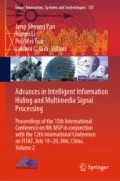Abstract
Generative adversarial networks have yielded outstanding results in unsupervised areas of learning, but existing research has proven that the results are not stable in specific areas. In this paper, an improved generative adversarial networks model is proposed. First, the loss calculation method of the generated model is changed, which makes the removal target of the whole network controllable. Second, the deep convolution network is added to the existing network; this improves the accuracy of the mosaic removal. And then combines the loss calculation method of the pixel networks, the network effectively solve the unstable features of generative adversarial networks in specific conditions. Finally, the experimental results show that the overall mosaic face removal for this network performance is superior to other existing algorithms.
Access this chapter
Tax calculation will be finalised at checkout
Purchases are for personal use only
References
Chung, K.H., Chan, Y.H.: Color demosaicing using variance of color differences. IEEE Trans. Image Process. 15(10), 2944–2955 (2006)
Li, X.: Demosaicing by successive approximation. IEEE Trans. Image Process. A Publ. IEEE Signal Process. Soc. 14(3), 370–379 (2005)
Zhang, L., Wu, X.: Color demosaicking via directional linear minimum mean square-error estimation. IEEE Press (2005)
Chen, X., Peng, X., Li, J.-B., Peng, Yu.: Overview of deep kernel learning based techniques and applications. J. Netw. Intell. 1(3), 83–98 (2016)
Xia, Y., Rong, H.: Fuzzy neural network based energy efficiencies control in the heating energy supply system responding to the changes of user demands. J. Netw. Intell. 2(2), 186–194 (2017)
Goodfellow, I.J., Pougetabadie, J., Mirza, M., et al.: Generative adversarial nets. Adv. Neural. Inf. Process. Syst. 3, 2672–2680 (2014)
Radford, A., Metz, L., Chintala, S.: Unsupervised representation learning with deep convolutional generative adversarial networks. Comput. Sci. (2015)
Arjovsky, M., Chintala, S., Bottou, L.: Wasserstein GAN (2017). arXiv:1701.07875
Gulrajani, I., Ahmed, F., Arjovsky, M., et al.: Improved training of Wasserstein GANs (2017). arXiv:1704.00028
Oord, A., Kalchbrenner, N., Vinyals, O., et al.: Conditional image generation with PixelCNN decoders (2016). arXiv:1606.05328
Li, Y., Liu, S., Yang, J., et al.: Generative face completion (2017). arXiv:1704.05838
Kingma, D.P., Ba, J., Lei: Adam: a method for stochastic optimization (2014). arXiv:1412.6980
Tieleman, T., Hinton, G.: Lecture 6.5—RmsProp: divide the gradient by a running average of its recent magnitude. In: COURSERA: Neural Networks for Machine Learning (2012)
Rasmus, A., Valpola, H., Honkala, M., Berglund, M., Raiko, T.: Semisupervised learning with ladder network (2015). arXiv:1507.02672
Ioffe, S., Szegedy, C.: Batch normalization: accelerating deep network training by reducing internal covariate shift (2015). arXiv:1502.03167
Dosovitskiy, A., Fischer, P., Springenberg, J.T., Riedmiller, M., Brox, T.: Discriminative unsupervised feature learning with exemplar convolutional neural networks. IEEE Trans. Pattern Anal. Mach. Intell. 99 (2015)
Dahl, R., Norouzi, M., Shlens, J.: Pixel recursive super resolution super resolution (2017). arXiv:1702.00783
Arjovsky, M., Bottou, L.: Towards principled methods for training generative adversarial networks. NIPS 2016 Workshop on Adversarial Training
Acknowledgements
This work was supported by National Natural Science Foundation of China (No. U1536121, 61370195).
Author information
Authors and Affiliations
Corresponding author
Editor information
Editors and Affiliations
Rights and permissions
Copyright information
© 2020 Springer Nature Singapore Pte Ltd.
About this paper
Cite this paper
Wang, H., Cao, Z., Niu, S., Tong, H. (2020). Mosaic Removal Algorithm Based on Improved Generative Adversarial Networks Model. In: Pan, JS., Li, J., Tsai, PW., Jain, L. (eds) Advances in Intelligent Information Hiding and Multimedia Signal Processing. Smart Innovation, Systems and Technologies, vol 157. Springer, Singapore. https://doi.org/10.1007/978-981-13-9710-3_37
Download citation
DOI: https://doi.org/10.1007/978-981-13-9710-3_37
Published:
Publisher Name: Springer, Singapore
Print ISBN: 978-981-13-9709-7
Online ISBN: 978-981-13-9710-3
eBook Packages: Intelligent Technologies and RoboticsIntelligent Technologies and Robotics (R0)

